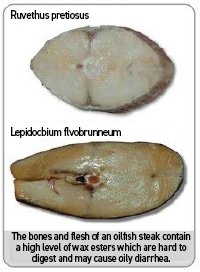Cod vs. Oilfish
Q1: For all the fish that are labelled as “cod”, are they all real “cod”?
A1: Common names are often used for fish selling on the market. “Cod” is used as a common name for many fish species, but not all fish that use this common name belong to the order Gadiformes. For example, fish that are labelled as “‘silver cod” and “white cod” do not belong to the order Gadiformes. Nonetheless, unlike oilfish, the fish that have been using these 2 common names generally do not pose any potential health risks, so these common names are still being used on the market nowadays.
Q2: The “Oilfish Incident” in Hong Kong
A2: In 2007, a number of Hong Kong people complained of oily diarrhoea after consuming fish labelled as “cod”. After investigation, it was found that the fish that were sold under the name of “cod” or similar names were in fact “oilfish”. The Centre for Food Safety subsequently formed a working group comprising representatives from relevant organisations and groups to develop the Guidelines on Identification and Labelling of Oilfish/Cod (the “Guidelines”) for the industry.
Q3: Why does oilfish trigger diarrhoea?
A3: The scientific names of the 2 fish species associated with oily diarrhoea are Ruvettus pretiosus (or commonly known as “oilfish”) and Lepidocybium flavobrunneum (or commonly known as “Escolar”) (collectively referred to as “oilfish”). Both species are rich in fat and contain naturally present wax esters.
Wax esters cannot be decomposed by thawing or cooking, and can be difficult for human to digest and will accumulate in the rectum. Some people may experience diarrhoea, stomach cramps or other discomfort after consumption. These symptoms usually appear within 30 minutes to 36 hours after consumption, and most people with recover within 2 days.
The amount of wax esters that triggers discomfort in human is still unknown. People who are pregnant, or with gastrointestinal problems or malabsorption should avoid eating “oilfish”.

Q4: Oilfish is usually sold in the form of fish steak or filet. How can consumers make a distinction?
A4: Since it is difficult to make a distinction based on the fish’s appearance, to help consumers, the Guidelines recommend that retailers and food suppliers should label Ruvettus pretiosus and Lepidocybium flavobrunneum as “oilfish” in English and “蠟油魚” in Chinese as their common names, and no other common names should be used. Furthermore, traders should also provide supplementary information of “oilfish” to consumers, such as potential health risks and cooking methods.
(Image) A detailed food label with the fish’s scientific and common name in accordance with the recommendations of The Food and Agriculture Organization of the United Nations.
A not-so-detailed food label with the fish’s common name in Chinese only.
Consumers who purchase fish labelled as “oilfish” should reduce the risk by using a cooking method that can remove most of the fat content (e.g. grilling) and discarding the broth. When eating these fish for the first time, try a small quantity and observe for signs and symptoms that may appear after consumption. Do not eat again if you experience gastrointestinal discomfort after consumption. If symptoms persist, seek medical attention as soon as possible.
Salmon vs. Rainbow Trout
Q1: What is the difference between salmon and rainbow trout?
A1: Actually, both rainbow trout and salmon belong to the family “Salmonidae”, but rainbow trout is mostly found in freshwater rivers/lakes, while adult salmon (over 2 years) mainly lives in the ocean.
Q2: Why do we need to make such a fine distinction since they belong to the same family Salmonidae?
A2: Consuming undercooked fish may pose risks of parasitic infection. For example, eating undercooked marine fish may pose risks of infection by Anisakis (a type of roundworm) and certain types of tapeworms, while eating undercooked freshwater fish may pose risks of infection by Chinese liver fluke (Clonorchis sinensis) or Thai liver fluke (Opisthorchis viverrini).
Infection of Chinese liver fluke or Thai liver fluke is endemic in Southeast Asia. In a 2010 study, it was found that 36.7% of farmed freshwater fish in the Pearl River Delta contained Chinese liver fluke. The proportion of wild freshwater fish containing Chinese liver fluke was even higher at 40.5%. For example, the proportion of grass carp that contained Chinese liver fluke could be as high as 52.4%.
Chinese liver fluke and Thai liver fluke can cause obstruction of the bile duct and may lead to cholangiocarcinoma (bile duct cancer), and are classified as Group 1 carcinogens by the International Agency for Research on Cancer.
Q3: Would it be easy for consumers to buy the wrong fish in Hong Kong?
A3: The Consumer Council previously purchased 31 sashimi samples that were labelled as salmon from supermarkets, food stores and restaurants, of which 30 of them were Salmo salar (or commonly known as Atlantic Salmon).
The remaining sample was actually Oncorhynchus mykiss (or commonly known as rainbow trout) but was labelled as “silver salmon” on the store’s menu. Despite a specific request for salmon by the Council’s representative when making the purchase, the sample bought turned out to be rainbow trout instead.

In the past, some media invited experts to share their experience, but there is no official guideline on how to distinguish between salmon and rainbow trout with the naked eye. When purchasing prepackaged fish steaks or filets, or ordering food at restaurants, consumers should pay attention to the names (including both the common and scientific names) indicated on the labels or menus to make sure that they are actually selecting the right species.
Want to learn more about fish? You may refer to the articles “Read the Labels to Distinguish Between OilFish and Cod” (Chinese version only) in Issue #371 of CHOICE Magazine and “10 Tuna Sashimi Samples with Methylmercury Exceeded the Statutory Limit Parasites Detected in 2 Samples” (Chinese version only) in Issue #510 of CHOICE Magazine.






![[Handwashing Cold Knowledge] Debunking 4 common handwashing myths](/f/guide_detail/409326/376c212/43_4%E5%80%8B%E6%B4%97%E6%89%8B%E5%B8%B8%E8%A6%8B%E8%BF%B7%E6%80%9D_Eng.jpg)





